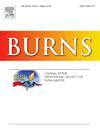The impact of subdermal adipose derived stem cell injections and early excision on systemic oxidative stress and wound healing in rats with severe scald burns
IF 3.2
3区 医学
Q2 CRITICAL CARE MEDICINE
引用次数: 0
Abstract
Aim
This study aims to develop an experimental treatment model effective against oxidative stress in the acute period of severe burns and to analyze the mechanisms of healing large wound defects.
Methods
Five rats, including 2 females and 3 males, were used as donors to obtain adipose-derived stem cells (ADSC) from the inguinal fat pad. The stem cells were labeled with green fluorescent protein. The study included four groups of 17 rats, each with grade 3 scalding burns on 30 % of their body surface, and a control group of 10 rats with an equal number of males and females. After early excision, 106 ADSC-derived stem cells were administered subdermally to the burned wound and autografted to the stem cell group (n = 17). The early excision group (n = 17) received early excision and autograft, with 2 ml of normal saline injected subdermally into the burn wound edge. The PLM group (n = 17) was treated with a polylactic membrane (PLM) dressing after the burn. No treatment was given to the burn group (n = 17). Ten rats from all groups were sacrificed on the 4th day post-burn for oxidative stress evaluation. The control group (n = 10) was sacrificed on day 4. Blood and tissue samples were collected post-sacrifice. Oxidative stress and inflammation in the blood, as well as cell damage in the skin, liver, kidneys, and lungs, were investigated histopathologically and biochemically on the 4th day post-burn. On the 70th day after burn, wound healing was examined macroscopically and histopathologically.
Results
On the 4th day, oxidative stress results showed that the levels of Total Oxidative Capacity (TOC) in the blood were lowest in the stem cell (7.4 [6–8.8]), control (6.7 [5.9–7.6]), and early excision (7.5 [6.6–8.5]) groups, with no significant difference between them. The burn group (14.7 [12.5–16.9]) had the highest TOC levels. The PLM group (9.7 [8.6–10.7]) had lower TOC levels than the burn group but higher levels than the other groups.
Histopathological examination on the 4th day revealed low liver caspase-3 immunoreactivity in the stem cell and early excision groups among the burn groups. Caspase-3 immunoreactivity levels were as follows: stem cell group (20 [10–30]), early excision group (25 [15–50]), PLM group (70 [50–100]), control group (0), and burn group (80 [60–120]). Other oxidative stress and end-organ damage outcomes were consistent with these results.
All rats in the stem cell group had burn wounds that healed completely by the 70th day. Examination of the skin and its appendages from the stem cell group with an immunofluorescence microscope demonstrated green coloration, indicating incorporation of stem cells.
Conclusion
Stem cells may have the potential to form new skin and its appendages, providing better healing for large skin defects. Early excision treatment, by removing local necrotic tissues after extensive and deep burns, can prevent end-organ damage due to systemic oxidative stress and inflammation. We also believe that when these two treatments are used together, they can achieve the best results.
皮下脂肪干细胞注射和早期切除对严重烫伤大鼠全身氧化应激和伤口愈合的影响
目的:本研究旨在建立一种在严重烧伤急性期有效对抗氧化应激的实验治疗模型,并分析大面积创面缺损的愈合机制:方法:以5只大鼠(2雌3雄)为供体,从腹股沟脂肪垫获取脂肪源性干细胞(ADSC)。干细胞用绿色荧光蛋白标记。研究包括四组,每组17只大鼠,每只大鼠体表30%的面积被3级烫伤;对照组10只大鼠,雌雄数量相等。早期切除后,106个ADSC衍生干细胞被注射到烧伤创面的皮下,并自体移植到干细胞组(n = 17)。早期切除组(n = 17)接受早期切除和自体移植,并在烧伤创缘皮下注射2毫升生理盐水。聚乳酸膜组(n = 17)在烧伤后使用聚乳酸膜敷料。烧伤组(n = 17)不做任何处理。烧伤后第 4 天,各组中的 10 只大鼠被处死,以进行氧化应激评估。对照组(n = 10)在第 4 天牺牲。牺牲后收集血液和组织样本。烧伤后第 4 天,对血液中的氧化应激和炎症以及皮肤、肝脏、肾脏和肺部的细胞损伤进行组织病理学和生物化学研究。烧伤后第 70 天,对伤口愈合进行宏观和组织病理学检查:结果:第4天,氧化应激结果显示,干细胞组(7.4 [6-8.8])、对照组(6.7 [5.9-7.6])和早期切除组(7.5 [6.6-8.5])血液中的总氧化能力(TOC)水平最低,三组之间无显著差异。烧伤组(14.7 [12.5-16.9])的总有机碳含量最高。PLM 组(9.7 [8.6-10.7])的 TOC 含量低于烧伤组,但高于其他组。第 4 天的组织病理学检查显示,在烧伤组中,干细胞组和早期切除组的肝脏 Caspase-3 免疫反应度较低。Caspase-3免疫反应水平如下:干细胞组(20 [10-30])、早期切除组(25 [15-50])、PLM组(70 [50-100])、对照组(0)和烧伤组(80 [60-120])。其他氧化应激和内脏损伤结果与上述结果一致。干细胞组所有大鼠的烧伤伤口都在第70天完全愈合。用免疫荧光显微镜检查干细胞组大鼠的皮肤及其附属器官,发现其呈绿色,表明干细胞的加入:结论:干细胞可能具有形成新皮肤及其附属物的潜力,为大面积皮肤缺损提供更好的愈合效果。大面积深度烧伤后,通过早期切除治疗,去除局部坏死组织,可防止因全身氧化应激和炎症引起的内脏损伤。我们还相信,当这两种治疗方法同时使用时,可以达到最佳效果。
本文章由计算机程序翻译,如有差异,请以英文原文为准。
求助全文
约1分钟内获得全文
求助全文
来源期刊

Burns
医学-皮肤病学
CiteScore
4.50
自引率
18.50%
发文量
304
审稿时长
72 days
期刊介绍:
Burns aims to foster the exchange of information among all engaged in preventing and treating the effects of burns. The journal focuses on clinical, scientific and social aspects of these injuries and covers the prevention of the injury, the epidemiology of such injuries and all aspects of treatment including development of new techniques and technologies and verification of existing ones. Regular features include clinical and scientific papers, state of the art reviews and descriptions of burn-care in practice.
Topics covered by Burns include: the effects of smoke on man and animals, their tissues and cells; the responses to and treatment of patients and animals with chemical injuries to the skin; the biological and clinical effects of cold injuries; surgical techniques which are, or may be relevant to the treatment of burned patients during the acute or reconstructive phase following injury; well controlled laboratory studies of the effectiveness of anti-microbial agents on infection and new materials on scarring and healing; inflammatory responses to injury, effectiveness of related agents and other compounds used to modify the physiological and cellular responses to the injury; experimental studies of burns and the outcome of burn wound healing; regenerative medicine concerning the skin.
 求助内容:
求助内容: 应助结果提醒方式:
应助结果提醒方式:


